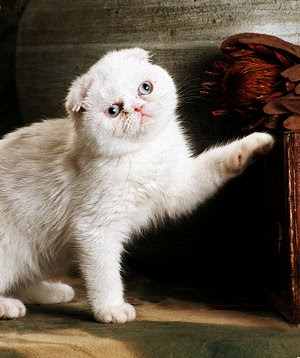We must go back 40–50 million years in the evolution of animals to identify the cat’s ancestors. The earliest ancestors were called Miacis (pronounced my-a-kiss). The Miacis were creatures about the size of a lynx, with long slender bodies, long tails, and short legs with retractable claws that extended from the paws during such activities as climbing trees or fighting. Over the next 10 million years, the Dinictis evolved bringing higher intelligence and greater agility to an animal more like the cat of today.
The first sign of domestication of cats appears to be around 8000 years ago. The earliest remains were found in Africa. Overwhelming evidence points to Ancient Egypt and the African Wildcats (Felis Sylvestris libyca) as the oldest truly domestic cats. They were probably used in farming villages to hunt the river rats that invaded the granaries. Feline remains were found on Cyprus dating back to 5000 B.C., but wild cats did not occur naturally on Cyprus, so they had to have been brought there.
 |
| Foldex Cat |
In Egypt, cats were so special that they came to be considered sacred. The earliest mention of the cat as sacred is in the Book of The Dead dating back to 3500 B.C. The cat was the symbol for the sun god Osiris or Re. About this time, it is said that Bast (the wife, sister, or daughter of Re) fled from Re and assumed the shape of a cat, thus becoming the goddess that protects cats. She is known as the goddess of the night and the moon. She protected crops and ensured a rich harvest. Her temples became sanctuaries for cats. When cats died, they were usually embalmed, given ceremonial rites, and buried in special cemeteries. The killing of cats was a crime punishable by death. Egypt prohibited the export of cats.
It is believed that Phoenicians and Greeks may have been the first to bring cats to Europe, starting around 2000 B.C. They likely used them for rat control on their ships, then sold or traded the cats at ports in Europe. Once on land, the Greeks, Romans, and others used the cats for rodent control. The cats did well in Europe,
enjoying the protection of the Church until the 10th century. During the Middle Ages, cats lost favor with the Church and were blamed for anything evil. They were often burned. Their fur was used for clothing and their flesh was eaten during the famines. Cats were connected to witchcraft clear into the 1700’s.
 |
| German Rex |
Cats were treated much better in the Orient. In China, the cat became a symbol for good fortune, peace, and beauty. Buddhists admired the cat’s meditative powers. The domestic cat arrived in Japan about 600 A.D., which was about the same time Buddhism was introduced to Japan. The Maneki Neko (beckoning cat) is one of the most common lucky charms seen in Japan. This figure of a sitting cat with the left front paw raised is frequently seen in shop windows where it is inviting customers to enter. The same figure with the right paw
raised attracts money and good fortune. With the Japanese appreciation of simple artistic form, cats are seen as a being of rare beauty.
During the 17th Century, attitudes toward the cat began to change for the better. Cats found a special spot in the family household and eventually became the beloved pets they are today. The cat’s progress was significantly improved in the 19th Century, the Victorian Era, which saw an improvement in the treatment of all
domestic animals. The Victorian Era also saw an increasing enthusiasm for exhibiting and breeding cats. The first cat show was held in London, England, on July 13, 1871, at The Crystal Palace. There were 160 cats for display and competi tion. During the late 1800’s interest in breeding and showing began to spread abroad. The first American cat show was held in Madison Square Garden, New York City in 1895. In 1904, the Cat Fancier’s Association (CFA) began a registry of pedigreed cats in America.
The cats of today are approximately the same size and shape as the ancient cats. They have retained their keen hunting instincts and selfreliance, make the same purring sounds, and display the same aloofness and affection.



 6:34 AM
6:34 AM

 Posted in:
Posted in: 





0 comments:
Post a Comment